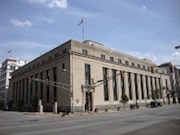Safety Modifications to Historic Buildings
The U.S. Post Office and Courthouse in South Bend, IN, designed by N. Roy Shambleau, was completed in 1933. Still in use today by the U.S. District Court for the Northern District of Indiana, it was renamed in 1992 as the Robert A. Grant Federal Building and United States Courthouse. The building is on the National Register of Historic Places, meaning that modifications to the exterior are not permitted. Any modifications to the function of the building must occur in such a way that the exterior remains true to its original design.

A problem arose with the buildings original design which did not exist when it was completed. Each floor had an outside air intake serving the buildings multiple air conditioning systems. The problematic outside air intake was located on the side of the building which today is an alleyway. It is difficult to know what this space was in 1933. It may have been a large open space, but due to expansion of the downtown district, this side of the building has become an alleyway.
Semi-tractor trailer drivers frequently park their trucks in the alleyway while approaching the shipping and receiving areas that share this common alleyway. How does this affect the outside air intake? It is common practice to leave diesel engines idling rather than shut them off and restart them during frequent delivery stops. The outside air intake for the court house was located 14’-2” above the alleyway, the exact height of a smokestack on a diesel engine truck. Fumes exiting the diesel engine trucks were being sucked into the building through the outside air intake. The air intake system that was originally constructed in 1933, and which worked fine for many years, was no longer acceptable. Was the original architect at fault? Absolutely not. The original architect probably had no clue what a diesel engine truck was. Was the truck driver at fault? Absolutely not. There is no way to control what was provided in a downtown area where deliveries needed to be made. So, although it may not be clear as to who caused the problem, there is one rule which must be applied: the rule of change.
Once the problem was identified, it was too dangerous to leave the facility in its current condition while taking the time to determine who was at fault. A situation that leaves people in an area where the potential of carbon monoxide poisoning exists, as was the case here, requires immediate attention. In this case of a building on the National Register of Historic Places, modifications that would affect the outside of the building appearance were not permitted. The solution was to cap the original 6’-0” x 6’-0” outside air intake inside the louver to maintain the overall appearance of the exterior of the building. A new outside air intake was installed on the roof, far away from the alleyway and thereby solving the problem.

Robert Klar
Robert graduated in 1972 from the University of Cincinnati with a bachelor's degree in Mechanical Engineering in the Urban Option. He also completed The Little Red Schoolhouse training course by Bell and Gossett and both Trane's and Carrier's HVAC design courses. He has been working proactively as an engineering designer for over 35 years, performing research in facility energy analyses, water quality studies, air quality analyses, and performance studies. In addition, his intuitive abilities to determine the causes of malfunctions have been repeatedly demonstrated. He was the project manager on a massive study of 26 of Ohio's reserve military bases to determine every instant of cross-connection and recommend its remediation. His designs have included HVAC, plumbing, irrigation, fountain design, and fire protection and his experience encompasses commercial, educational, government, health care, and industrial facilities.

